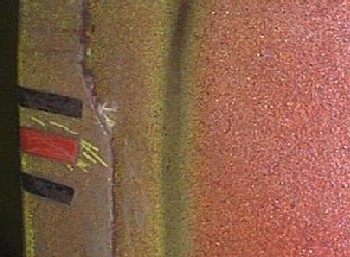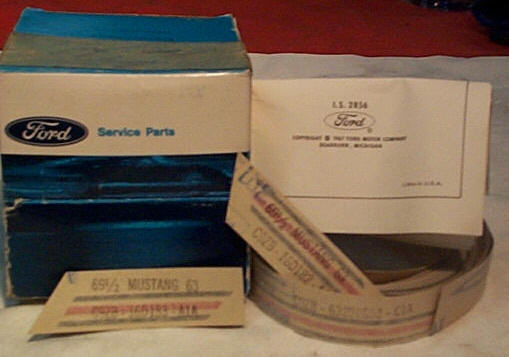May 18, 2004 is officially the first day that I started working on the project. My first restoration goal is to get the shell redone and in final primer.
Then the plan is to put the rest of the sheetmetal in final primer so that I can get the car painted (UPDATE: car was painted on July 3,2006). The first task on a project like this is to fully dismantle the car.
I won't go into detail on how I dismantled things, but I will describe some of the important items that need to be recorded during the dismantling process.
|
 I made a great discovery during the tare-down. I found pieces of the original factory pinstripes ! When I removed the right front fender I saw the ends of the pinstripes on the inside. It was a three
strip pinstripe as Don's was. The outer two stripes were black and only the glue remained for the inner. However, when I checked the inside front edge of the passenger's door I found all three intact.
The middle color was red. Searching for more evidence I found pieces of the pinstripe on the front inside edge of the driver's door. Literally digging a little deeper, I found the ends of the pinstripes
buried underneath two layers of paint inside the door jambs and on the inside rear lip of the doors. So know I know that most likely all Groovy Green Limited Edition 600's came with black/red/black Ford pinstripes,
or at least just mine.
I made a great discovery during the tare-down. I found pieces of the original factory pinstripes ! When I removed the right front fender I saw the ends of the pinstripes on the inside. It was a three
strip pinstripe as Don's was. The outer two stripes were black and only the glue remained for the inner. However, when I checked the inside front edge of the passenger's door I found all three intact.
The middle color was red. Searching for more evidence I found pieces of the pinstripe on the front inside edge of the driver's door. Literally digging a little deeper, I found the ends of the pinstripes
buried underneath two layers of paint inside the door jambs and on the inside rear lip of the doors. So know I know that most likely all Groovy Green Limited Edition 600's came with black/red/black Ford pinstripes,
or at least just mine.
|
|
 The search for NOS pinstripes didn't take me long. I couldn't find any at Carlisle, but within a week after returning home a set showed up on e-bay which I managed to get for $26. For those
that care the Ford partnumber for the black-red-black pinstripe kit for the Groovy Green Sportsroof bodystyle is C9ZZ-6320000-T.
The search for NOS pinstripes didn't take me long. I couldn't find any at Carlisle, but within a week after returning home a set showed up on e-bay which I managed to get for $26. For those
that care the Ford partnumber for the black-red-black pinstripe kit for the Groovy Green Sportsroof bodystyle is C9ZZ-6320000-T.
|
|
|
By May 28th I had the car stripped down to a rolling shell. There was nothing on it except for the front and rear suspension.
It took me approximately 14 hours to do this. This time includes the time it took to take several hundred digital pictures of the tare-down. By this time I had a very complete list of parts I would
need to complete the project. My list was much shorter than it had originally been since I had been buying NOS and used parts for it ever since I got the car. Since I was planning on going to
the Ford Nationals in Carlisle PA, I needed the list to be as complete as possible.
|
|
| ON THE SUBJECT OF COLOR |
|
It is known that the Limited Edition Mustangs were available in two colors according to the sales literature (refer to Don's website). Based on the known examples of these cars
which all have their tags intact, it is known that the colors were not standard 1969 Ford colors. The buck tags on the orange cars had a color code of "WT5185" and the green ones had "MX8241928". This makes
the identification of the colors very difficult. Without an actual model year paint code that can be identified using paint chips, computer color matching is the only tool available for getting new paint
mixed. With some help from an expert, Don was able to identify his orange color as a 1965 Ford Poppy Red. It just so happens that "WT5185" was also a special order color that was available on
1968 Shelby's. As far as I know, no one had truly identified the color of the green code (MX8241928). It was reported to Don that the color was a 1956 Mercury Grove Green. By comparing paint chips from
two different paint manufacturers to the actual color found inside my car, it was very easy to see that this wasn't true. I then started to compare the color to the Ford paintchip sets that I had. I very quickly
identified the color as a 1972 Ford Bright Lime code 4E, which was first available in the Spring of 1971. To further prove this I had a pint of paint mixed in a PPG Deltron basecoat/clearcoat system, since that
was going to be the paint system I was hoping to use on the car. I painted my new trunklid that I had bought at Carlisle since it was already in primer. The color was a perfect match ! I set the trunklid in place on
the car where I was able to compare it to the original color under different lighting conditions. Just like the original paint the trunklid color is a bright glowing yellow under direct sunlight and a lime green
when it is overcast or when it is getting dark near sunset.
My theory for special order color cars, is that if the code begins with a "WT" then the color was used in previous years or was in the Ford Special Order Paint Selector chip set (there are over 200 paint chips in these sets).
If the color code begins with "MX" then the color is a special mix that has never been used before or (as it turns out) is was used on another Ford line (Mercury, Lincoln, etc). This theory seems to hold true for the several examples of special order colors that I've ever seen (like the first
Playboy Pink cars). Don theorizes that Ford used the Limited Edition 600's to test market the green color. This may be true, at least in part, because the color was eventually used on later models. But Ford started using the green a couple years after Chrysler introduced a simular lime color as part of their high-impact color line-up.
|
 I made a great discovery during the tare-down. I found pieces of the original factory pinstripes ! When I removed the right front fender I saw the ends of the pinstripes on the inside. It was a three
strip pinstripe as Don's was. The outer two stripes were black and only the glue remained for the inner. However, when I checked the inside front edge of the passenger's door I found all three intact.
The middle color was red. Searching for more evidence I found pieces of the pinstripe on the front inside edge of the driver's door. Literally digging a little deeper, I found the ends of the pinstripes
buried underneath two layers of paint inside the door jambs and on the inside rear lip of the doors. So know I know that most likely all Groovy Green Limited Edition 600's came with black/red/black Ford pinstripes,
or at least just mine.
I made a great discovery during the tare-down. I found pieces of the original factory pinstripes ! When I removed the right front fender I saw the ends of the pinstripes on the inside. It was a three
strip pinstripe as Don's was. The outer two stripes were black and only the glue remained for the inner. However, when I checked the inside front edge of the passenger's door I found all three intact.
The middle color was red. Searching for more evidence I found pieces of the pinstripe on the front inside edge of the driver's door. Literally digging a little deeper, I found the ends of the pinstripes
buried underneath two layers of paint inside the door jambs and on the inside rear lip of the doors. So know I know that most likely all Groovy Green Limited Edition 600's came with black/red/black Ford pinstripes,
or at least just mine.
 The search for NOS pinstripes didn't take me long. I couldn't find any at Carlisle, but within a week after returning home a set showed up on e-bay which I managed to get for $26. For those
that care the Ford partnumber for the black-red-black pinstripe kit for the Groovy Green Sportsroof bodystyle is C9ZZ-6320000-T.
The search for NOS pinstripes didn't take me long. I couldn't find any at Carlisle, but within a week after returning home a set showed up on e-bay which I managed to get for $26. For those
that care the Ford partnumber for the black-red-black pinstripe kit for the Groovy Green Sportsroof bodystyle is C9ZZ-6320000-T.